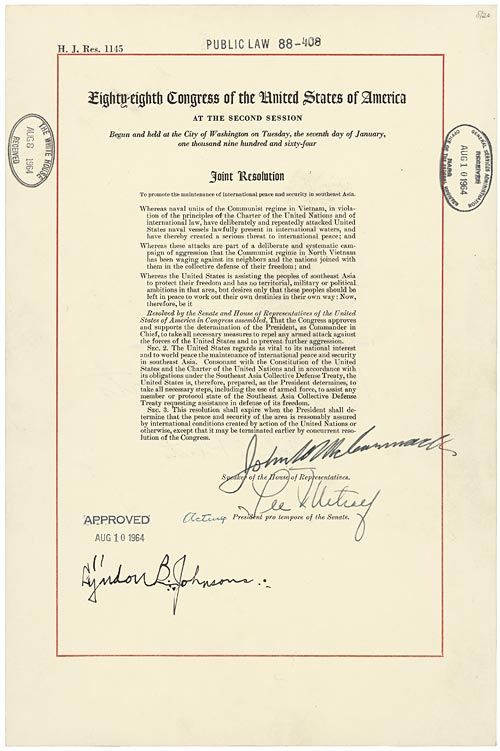
Tonkin Gulf Resolution (1964)
This joint resolution of Congress (H.J. RES 1145), dated August 7, 1964, gave President Lyndon Johnson authority to increase U.S. involvement in the war between North and South Vietnam.
On the evening of August 4, 1964, President Lyndon Johnson addressed the nation in a televised speech in which he announced that two days earlier, U.S. ships had been attacked twice in international waters in the Gulf of Tonkin near North Vietnam. Johnson dispatched U.S. planes against the attackers and asked Congress to pass a resolution to support his actions.
There was little debate in Congress, and the joint resolution "to promote the maintenance of international peace and security in southeast Asia" passed on August 7, with only two Senators (Wayne Morse and Ernest Gruening) dissenting.
The Tonkin Gulf Resolution became the subject of great political controversy in the course of the undeclared war that followed. It stated that "Congress approves and supports the determination of the President, as Commander in Chief, to take all necessary measures to repel any armed attack against the forces of the United States and to prevent any further aggression." As a result, President Johnson, and later President Nixon, relied on the resolution as the legal basis for their military policies in Vietnam.
There were two incidents in the Gulf of Tonkin in the days preceding Johnson's speech. On August 2 – the first Tonkin Gulf incident – North Vietnamese torpedo boats were spotted and attacked the destroyer USS Maddox. The Maddox was conducting electronic eavesdropping on North Vietnam to assist South Vietnamese Army (ARVN) commando raids on North Vietnamese targets, but that wasn't publicly known at the time. Historians now suspect the North Vietnamese boats had set out to attack an ARVN raid in progress when it encountered the Maddox.
Then on August 4, the USS Maddox captain reported a second incident, that he was "under continuous torpedo attack." He later cabled "freak weather effects on radar and overeager sonarmen may have accounted for many reports," but Defense Secretary Robert McNamara did not report the captain's doubts to President Johnson. (A 2002 National Security Agency report made available in 2007 confirmed the August 2 attack, but concluded the August 4 attack never happened.)
Johnson portrayed confrontations between U.S. and North Vietnamese ships off the coast of North Vietnam as unprovoked aggression when he addressed Congress. When contrary information later surfaced, many believed Congress had been conned, but it was too late.
The Gulf of Tonkin act became more controversial as opposition to the war mounted. A Senate investigation revealed that the Maddox had been on an intelligence mission in Tonkin Gulf, contradicting Johnson’s denial of U.S. Navy support of such missions. The Resolution was repealed in January 1971 in an attempt to curtail President Nixon’s power to continue the war.

